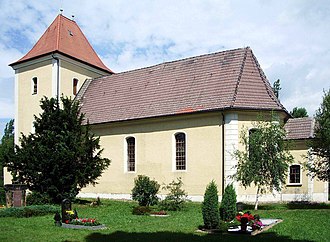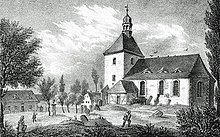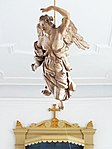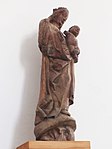Hohenheida Church
The Hohenheida Church is a church building of the Evangelical Lutheran Regional Church of Saxony in the Hohenheida district of Leipzig . It stands slightly elevated on the green of the former village, is surrounded by the cemetery and forms the center of the old village center. She enjoys monument protection .
history
The first church was built in the 12th or 13th century, possibly on an old cult site. After the Reformation Hohenheida became a university village in 1438 , that is, the University of Leipzig became a feudal lord and also took over the jurisdiction and the collature of the church.
Around 1500 the Romanesque hall church was rebuilt after it had received a new bell in 1440. In 1689/1690 the tower of the church was rebuilt on the old vault and a tower clock was installed five years later. The nave was rebuilt and extended in 1715/1716 and received its baroque appearance inside with galleries and pulpit altar .
The tower now had a baroque roof turret in the form of an open lantern .
In 1765 the church received the first organ. It was built by the Leipzig university organ builder Johann Emanuel Schweinfleisch . It had 14 manual and two pedal registers . In 1855 it was replaced by Urban Kreutzbach's instrument . (See below)
In 1864 the church was renovated and the access was moved from the annex on the south side to the tower. The internal fixtures were completely renewed except for the organ. It was not until 1963/1964 that the church was connected to the power grid, so that the bells could now also be rung electrically. When the roof was re-roofed in 1971, the turret of the tower was removed. In 1994 the church was extensively restored.
architecture
Due to its old age and numerous alterations, the Hohenheida church has Romanesque , Gothic and Baroque features. The transverse west tower in the width of the building still contains Romanesque masonry in its lower area. Access to the church takes place through him. The three floors of the tower barely rise above the roof ridge of the nave. The tower has short buttresses at two corners and has a hipped roof .
The approximately 20 m long and 10 m wide hall of the nave has a three-eighths closure in the east . A small sacristy annex adjoins its central part , also with a three-eighth closure. The corners of the keys are rusticated . The church has segmented arched windows .
Furnishing
A colored gallery runs around the interior on three sides. The flat ceiling has a simple stucco pattern. The altar is a simple pulpit altar. To the right and left of this there are colored stained glass windows from 1913 with the themes " Moses with the tablets of the law " and " Jesus as a good shepherd ". The neo-Gothic baptismal font dates from 1855. A baroque wooden angel from an earlier baptismal font from around 1720 hovers over the altar area. The furnishings also include a statue of the Virgin Mary ( crescent moon ) from around 1500 and a figure of Christ from the same period, both damaged and without color.
organ
The organ was built in 1855 by the Borna organ builder Urban Kreutzbach . It has fourteen registers on two manuals and a pedal . In 1994 the organ building company Georg Wünning from Großolbersdorf carried out a thorough restoration of the instrument. The disposition is as follows:
|
|
|
|||||||||||||||||||||||||||||||||||||||||||||||||||
- Coupling : II / I, I / P
Peal
There are three bronze bells in the historic belfry, which was renovated in 2008 . The largest, with a diameter of 106 cm and a weight of 703 kg, was cast in 1440. According to its inscription, it is called "Margarete" (possibly the earlier name of the church). The two smaller bells can be assigned to the 13th century. One of them was transported away to be melted down in World War II , but it was able to be returned after 1945.
Parish
The Hohenheida church belongs together with the churches in Gottscheina , Göbschelwitz , Plaußig , Portitz , Seehausen and Seegeritz to the parish of Plaußig-Hohenheida. At the Hohenheida Church there is a trombone choir, a church choir and a carolers .
The Saxony Pastors' Book lists pastors at the Hohenheida Church since 1527.
literature
- Vera Danzer, Andreas Dix: Leipzig - A regional history inventory in the Leipzig area . Ed .: Haik Thomas Porada . 1st edition. Böhlau, Cologne Weimar Vienna 2015, ISBN 978-3-412-22299-4 , pp. 237 .
- Cornelius Gurlitt : Hohenheida. In: Descriptive representation of the older architectural and art monuments of the Kingdom of Saxony. 16. Issue: Amtshauptmannschaft Leipzig (Leipzig Land) . CC Meinhold, Dresden 1894, p. 59.
- Hohenhayda. In: Saxony's church gallery. The inspections: Leipzig and Grimma. Leipzig 1844, pp. 101/102. (Digitized version)
- Christoph Kühn, Heidemarie Epstein: Gottscheina, Hohenheida, Göbschelwitz. A historical and urban study. Pro Leipzig e. V. (ed.). Leipzig 1999.
Web links
- Ev. Parish church Hohenheida. In: architecture-blicklicht. Retrieved February 8, 2020 .
- Hohenheida Church. In: Churches in Leipzig. Retrieved February 8, 2020 .
- Hohenheida Church. In: Ev. Luth. Parish of Plaußig-Hohenheida. Retrieved February 8, 2020 .
Individual evidence
- ↑ List of cultural monuments in Seehausen (Leipzig) , ID number 09256028
- ↑ Saxony's church gallery
- ↑ Gottscheina, Hohenheida, ... , p. 33.
- ↑ Ev. Parish church Hohenheida. In: architecture-blicklicht. Retrieved February 8, 2020 .
- ↑ ORKASA organ database. Retrieved February 2, 2020 .
- ↑ Church music. In: Parish website. Retrieved February 14, 2020 .
- ^ Pastor in Hohenheida. In: Pastor's Book of Saxony. Retrieved February 14, 2020 .
Coordinates: 51 ° 25 '14.7 " N , 12 ° 27' 3.4" E









